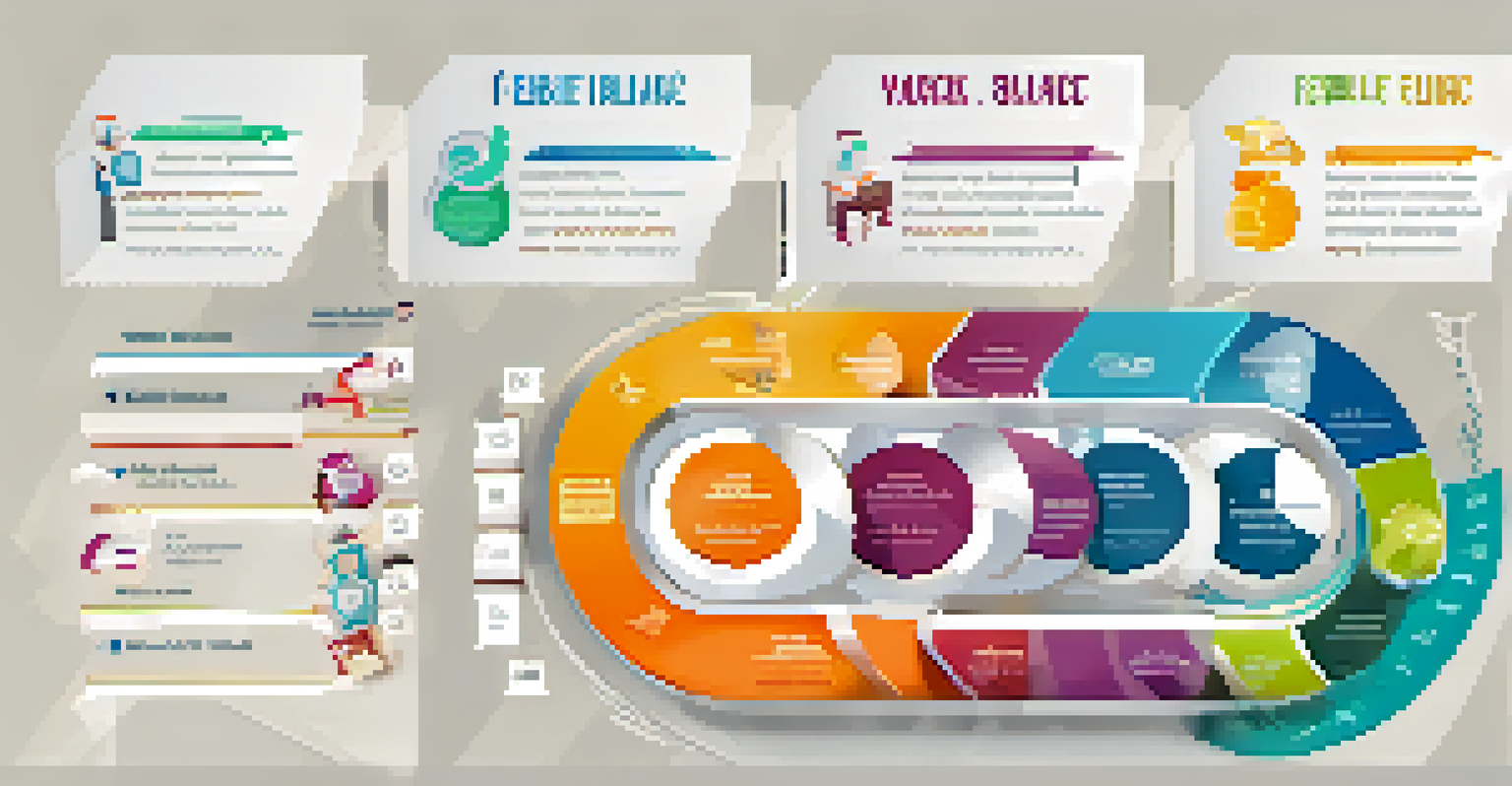Integrating Flexible Scheduling to Minimize Work Stress

Understanding the Importance of Flexible Scheduling
Flexible scheduling allows employees to choose their work hours, fostering a better work-life balance. This adaptability can lead to increased job satisfaction and productivity, as individuals can tailor their schedules to fit personal commitments. For example, a parent might prefer starting work earlier to accommodate school drop-offs, while a night owl might thrive with later hours.
Flexibility is the key to stability.
By recognizing that everyone has unique needs, organizations can create a more inclusive environment. This not only helps in retaining talent but also attracts new employees who seek a modern approach to work. As companies evolve, embracing flexibility is becoming a key factor in employee well-being.
Ultimately, when employees feel in control of their schedules, they are likely to experience reduced stress levels. This empowerment can lead to higher morale and a stronger commitment to the company, illustrating that flexibility is not just a perk but a strategic advantage.
The Connection Between Scheduling and Work Stress
Work stress often arises from rigid schedules that leave little room for adjustments. Employees juggling personal responsibilities alongside work commitments can feel overwhelmed, leading to burnout. For instance, an employee who has to choose between attending a family event or sticking to a strict work schedule may feel trapped and resentful.

By integrating flexible scheduling, businesses can alleviate this pressure. Allowing employees to shift their hours or work remotely can make it easier to manage personal obligations without sacrificing performance. This flexibility can transform a stressful environment into one where employees feel supported and valued.
Moreover, research shows that employees with flexible schedules report higher levels of job satisfaction. This positive correlation underscores the importance of adapting work hours to fit individual lifestyles, ultimately reducing stress and enhancing overall productivity.
Implementing Flexible Scheduling: Key Strategies
To successfully implement flexible scheduling, organizations should start by assessing employee needs. Conducting surveys or focus groups can provide valuable insights into how staff members want to structure their work hours. This collaborative approach ensures that the resulting policies are tailored to actual demands rather than assumptions.
The greatest weapon against stress is our ability to choose one thought over another.
Once the needs are identified, clear guidelines and expectations should be established. This includes defining core hours when all employees are expected to be available while allowing flexibility outside of those times. For example, a company might set a core time from 10 AM to 3 PM, encouraging employees to start earlier or finish later as per their preference.
Additionally, providing training for managers on how to effectively manage flexible teams is crucial. Managers should be equipped with tools to monitor productivity and maintain communication, ensuring that the transition is smooth and beneficial for all parties involved.
The Role of Technology in Flexible Scheduling
Technology plays a vital role in facilitating flexible scheduling, making it easier for employees to manage their hours. Tools like calendar apps, project management software, and communication platforms help teams stay connected regardless of their physical location or working hours. This digital support can bridge the gap created by non-traditional schedules.
For instance, a team using a shared project management tool can easily track progress and deadlines, ensuring accountability without requiring everyone to be online at the same time. This flexibility allows for a more asynchronous work style, where employees can contribute when they are most productive.
Moreover, technology can also help in tracking employee well-being. Regular check-ins through virtual meetings or wellness apps can provide insights into how flexible scheduling is impacting stress levels, allowing organizations to make adjustments as needed.
Measuring the Impact of Flexible Scheduling
Evaluating the effectiveness of flexible scheduling is essential to ensure it meets its intended goals. Organizations can track key performance indicators (KPIs) such as employee satisfaction, productivity levels, and turnover rates. Surveys and feedback mechanisms can provide qualitative data that complements these metrics.
For example, if a company notices an increase in productivity but a drop in team cohesion, it may need to tweak its approach. Perhaps adding more team-building activities or encouraging regular check-ins could enhance collaboration while maintaining flexibility.
Additionally, continuous assessment allows companies to stay agile and responsive to employee needs. This iterative process ensures that flexible scheduling evolves alongside the workforce, promoting a healthy and dynamic work environment.
Overcoming Challenges in Flexible Scheduling
While flexible scheduling offers numerous benefits, it can also present challenges. Some employees may struggle with boundaries, finding it hard to disconnect from work when their hours are fluid. Organizations should emphasize the importance of setting personal limits to avoid burnout.
It's also possible that team dynamics could shift, leading to feelings of isolation among remote workers. To combat this, companies should foster an inclusive culture that encourages regular communication and collaboration, regardless of employees' schedules.
Lastly, management buy-in is crucial for the success of flexible scheduling. Leaders must model the behavior they wish to see, demonstrating that they also value work-life balance. By addressing these challenges head-on, organizations can create a more resilient and adaptable workforce.
The Future of Work: Embracing Flexibility
As we look toward the future, flexible scheduling is likely to become a standard rather than an exception. The shift in workplace expectations, driven by the pandemic and evolving employee priorities, has made it clear that flexibility is crucial for attracting and retaining talent. Organizations that embrace this change are poised to thrive.
Companies must stay attuned to employee feedback, continuously refining their flexible scheduling policies to meet the evolving needs of their workforce. This adaptability will not only enhance employee well-being but also foster a culture of innovation and resilience.

In conclusion, integrating flexible scheduling is more than just a trend; it's a transformative approach that can significantly reduce work stress and improve overall job satisfaction. By prioritizing flexibility, organizations set themselves up for success in an ever-changing work landscape.